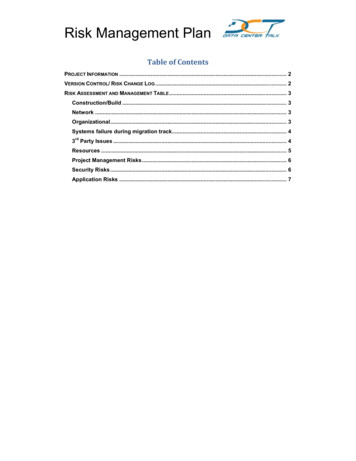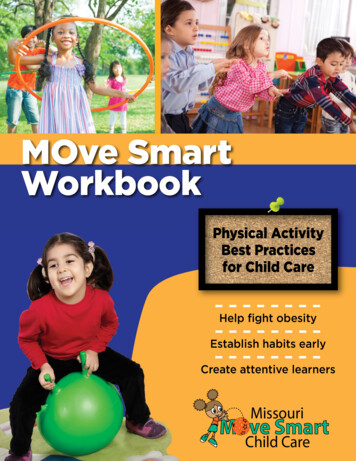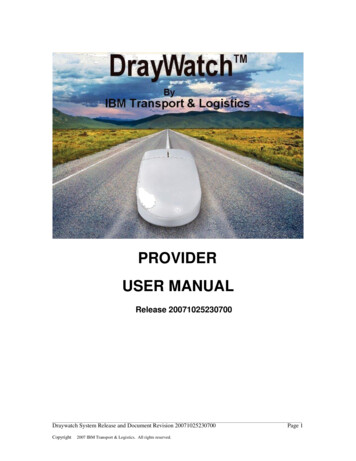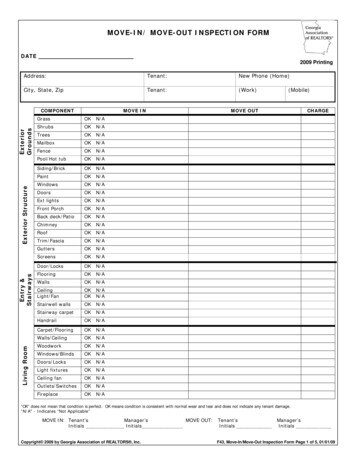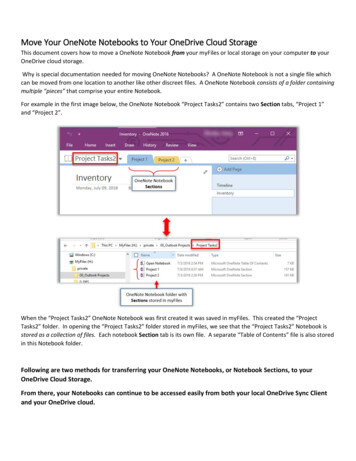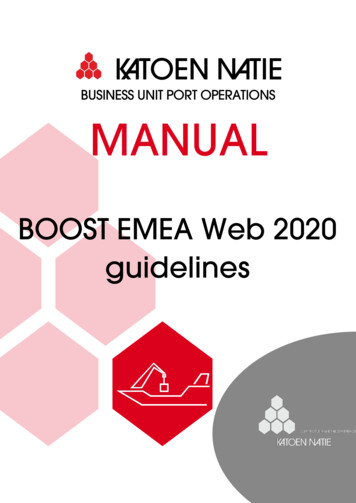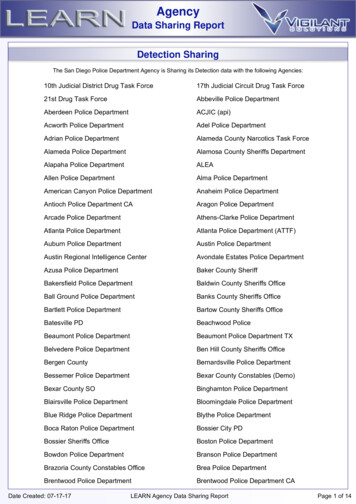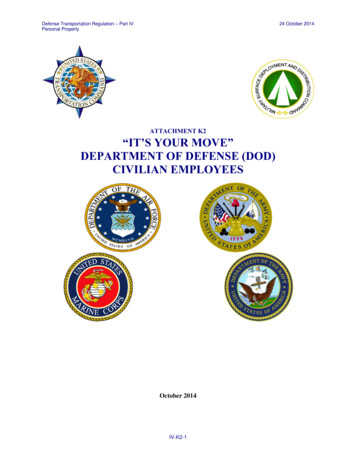
Transcription
Defense Transportation Regulation – Part IVPersonal Property24 October 2014ATTACHMENT K2“IT’S YOUR MOVE”DEPARTMENT OF DEFENSE (DOD)CIVILIAN EMPLOYEESOctober 2014IV-K2-1
Defense Transportation Regulation – Part IVPersonal Property24 October 2014TABLE OF CONTENTSATTACHMENT K2 - “IT’S YOUR MOVE” DEPARTMENT OF DEFENSE (DOD)CIVILIAN EMPLOYEES . K2-1A.Who is this Attachment For? . K2-3B.Defense Personal Property Program (DP3) . K2-3C.Defense Personal Property System (DPS) . K2-3D.Accessing DPS . K2-3E.Introduction. K2-4F.Valuable Tips . K2-4G.Weight Allowances . K2-4H.Motorcycle/Dirt Bike Shipments . K2-6I.When to Make Arrangements . K2-6J.Who to See . K2-6K.What you “May” Ship as HHG. K2-7L.What you “May Not” Ship as HHG . K2-7M.Professional Books, Papers &Equipment/Pro-Gear (PBP&E) . K2-8N.Alcoholic Beverage Shipment . K2-9O.Firearms . K2-10P.Gypsy Moth . K2-10Q.Personally Procured Movement (PPM) of HHG . K2-10R.Privately Owned Vehicle (POV) . K2-10S.Storage . K2-11T.Arranging the Move . K2-11U.Documentation . K2-12V.Responsibilities . K2-13W.Claims for Loss and Damage (FRV) . K2-17X.Purchasing Additional Insurance . K2-18Y.Service Claims Offices . K2-18Z.During and After the Move . K2-19AA.Web Sites to Visit . K2-19IV-K2-2
Defense Transportation Regulation – Part IVPersonal Property24 October 2014A. WHO IS THIS ATTACHMENT FOR?1. This attachment was created to assist Department of Defense (DOD) Civilian Employees. It isintended to help you understand your allowances and responsibilities involving the shipment andor storage of your Household Goods (HHG) and/or Unaccompanied Baggage (UB). Thisattachment does not apply to United States (US) Coast Guard Civilian employees as theirallowances are prescribed by the Federal Travel Regulation and Homeland Security policy. Thispolicy directive has been reviewed by the Per Diem, Travel and Transportation AllowanceCommittee (PDTATAC) according to DOD Directive 5154.29, DOD Pay and Allowances Policyand Procedures, as PDTATAC Case RR090701. Any conflict between this directive and the JointTravel Regulations (JTR), is resolved based on the JTR and not this directive.2. The contents contained in this attachment are not all inclusive of allowances. For additionalinformation, please consult the JTR or your local Transportation Office (TO) for up to dateinformation.B. DEFENSE PERSONAL PROPERTY PROGRAM (DP3)1. To improve your moving experience and streamline the process for those who support it, theDOD developed a new program called the Defense Personal Property Program (DP3). This newprogram focuses on meeting the needs of Armed Forces (Army, Navy, Air Force, Marine Corps,and Coast Guard) Members, DOD Civilian Employees, and their families by promoting quality ofservice.2. The backbone of the DP3 is the Defense Personal Property System (DPS) which automates andsimplifies your personal property move process.C. DEFENSE PERSONAL PROPERTY SYSTEM (DPS)1. As a centralized, integrated system, DPS supports the DP3 as the one-stop source for managingpersonal property moves. For the first time, the Military Surface Deployment and DistributionCommand (SDDC) has oversight of claims and Transportation Service Provider (TSP)information in one convenient location. In addition, DPS provides 24/7 access to personalproperty shipment information and a conduit for a direct relationship between DOD customersand TSPs throughout the entire moving process.2. Some highlights of DPS include the ability of DOD customers to use DPS to settle claims directlyonline with their TSP. Claims protection includes Full Replacement Value (FRV) of lost itemsand/or items damaged beyond repair, direct communications and claims settlement between thecustomer and the TSP. DPS becomes the focal point for all DOD Customers, TSPs, PersonalProperty Shipping Offices (PPSOs), the Service Headquarters (HQ), TO, and others whoparticipate in the personal property moving process.D. ACCESSING DPS1. First time DPS users must obtain an Electronic Transportation Acquisition (ETA) loginIdentification (ID) and password before accessing DPS.2. To obtain an ETA login ID and password, go to: http://www.move.mil.3. Once you have accessed Move.mil, click on "New to Move.mil -- First Time Users Click Here!"4. Follow instructions for checking browser capability and to obtain User ID and Password.5. After obtaining User ID and Password, select "Login to DPS".IV-K2-3
Defense Transportation Regulation – Part IVPersonal Property24 October 2014E. INTRODUCTION1. A successful move is not a matter of chance. It is the result of planning and hard work. At thecenter of these efforts is you, the customer. If you expect a good move, you must play an activerole.2. This attachment has been prepared to help you understand your allowances and responsibilitiesconcerning shipment and or storage of your HHG and/or UB. It also is intended to help youunderstand your allowances and responsibilities in the event you have to file a claim for lossand/or damage.3. For additional DPS user and personal property shipping information, please visithttp://www.move.mil or contact your local PPSO, TO, or Personal Property Processing Office(PPPO). Additional websites are listed at the end of this attachment.4. Your new unit may assign you a sponsor who should contact you some weeks in advance of yourreporting date. A sponsor can often provide information helpful to you in arranging a smoothmove. Contact your new unit if you have not heard from your sponsor within a reasonableperiod. It is your move. Ask questions. Read and understand what you sign. Get involved.F. VALUABLE TIPS1. Have expensive and valuable items (e.g., artwork, collectibles, heirlooms) appraised. TheGovernment does not pay for the appraisals, but consider this part of your investment in the eventof loss or damage. Attempt to locate original purchase receipts for your more expensive itemsand keep them separate from the rest of your shipment. Consider using a video camera or takingclose-up pictures to record the condition of your furniture, working condition of your stereo,television, and the actual appearance of your expensive and/or valuable items prior to the HHGpack/pickup dates. This could help in the event you must file a Loss/Damage Claim.2. Do not ship small, extremely valuable items such as stocks, bonds, jewelry, coins/coincollections, and items of great sentimental value such as photo albums. Pack them in yoursuitcases and hand-carry them, as well as your purchase receipts, pictures, and appraisals.G. WEIGHT ALLOWANCES1. HHG:a. In Accordance With (IAW) the JTR Chapter 5, the worldwide maximum weight of HHG thatmay be transported (and/or stored In Connection With [ICW] transportation) is 18,000pounds net weight for each employee.NOTE: HHG transportation time limitation is two years from the employee’s reporting date atthe new Permanent Duty Station (PDS).2. UB:a. IAW JTR Chapter 5, UB weight allowance is 350 pounds net weight for each adult anddependent age 12 or older and 175 pounds net weight for each child under age 12.b. UB is the part of an employee’s prescribed weight allowance of HHG that:(1) Is not carried free on a ticket used for personal travel,(2) Ordinarily is transported separately from the bulk of HHG, and(3) Usually is transported by an expedited mode because it is needed immediately or soonafter arrival at destinationIV-K2-4
Defense Transportation Regulation – Part IVPersonal Property24 October 2014c. UB shipped ICW permanent duty and Renewal Travel Agreement consists of:(1) Personal clothing and equipment.(2) Essential pots, pans and light housekeeping items.(3) Collapsible items such as playpens, cribs and baby carriages.NOTE: Items such as refrigerators, washing machines, major appliances, and furniture mustnot be included in UB.3. You, not your TO or your TSP, are responsible for staying within your authorized weightallowance. If the weight of items packed, shipped, or stored exceeds your weight allowance, yourService is responsible for collecting excess costs from you.4. For this reason, estimating the weight of your HHG is very important. Estimates should startearly, even before you visit your TO or before you prepare your application to ship and or storepersonal property in DPS. The counselor at your TO requires an estimated weight for eachshipment you intend to make.5. An easy and usually dependable method for making this estimate is to figure 1,000 pounds perroom (not including storage rooms or bathrooms), then add the estimated weight of largeappliances and items in the garage, storage rooms, basement. An optional method is to use the“Weight Estimator” at: http://www.move.mil/dod/before you begin/weight allowance.cfm thenaccess the “Weight Estimator” tab.6. Weight Estimates Not Official:a. Weight estimates are not official, they are planning tools only. You can never use weightestimates to refute excess weight charges.7. Excess Weight Can Cost Big Money:a. Exceeding your authorized weight allowance on a move can cost you a lot of money.Charges for excess weight can range from several hundred to several thousand dollars.b. Notification of overweight charges can take many months after your move is completed. Forshipments in excess of the authorized weight allowance, the employee is financiallyresponsible for all costs associated with the excess weight following transportationcompletion, as determined by the Service concerned. Payment for the transportation andcollection from the employee for excess charges are IAW finance regulations (JTR Chapter5). Contact your local TO for additional information regarding excess costs.8. Request for Reweigh:a. The TO at origin or destination can authorize a reweigh of your personal property shipment atyour request at no cost to you. This ensures a reweigh of your personal property is completedor scheduled prior to accepting delivery. If you are available when your shipment isreweighed, you have the right to witness the reweigh and/or request to see the reweigh ticketsfor verification.9. Overseas Weight Limitations:a. When Government furnishings are provided at an Outside Continental US (OCONUS)location, HHG transportation at Government expense to or from such an OCONUS locationordinarily is limited to 4,500 pounds net weight, not including UB weight.NOTE: Appropriate storage, or transportation to a designated place, is authorized for theremainder of an employee’s weight allowance.IV-K2-5
Defense Transportation Regulation – Part IVPersonal Property24 October 2014H. MOTORCYCLE/DIRT BIKE SHIPMENTS1. Generally, motorcycles and or dirt bikes can be shipped either as a separate Privately OwnedVehicle (POV) shipment, or in your HHG shipment. However, some countries do not allow theimportation of motorcycles and or dirt bikes. If shipped to a country which does not allow theirimportation, the entire HHG shipment and or motorcycle/dirt bike shipment may be held by theHost-Country Customs Officials and may not be released until the unauthorized shipment hasbeen corrected. This action may result in significant delays and a monetary inconvenience onyour part.2. Contact your local TO for details based on Host-Country requirements to which being assignedto, or you may consult the Personal Property Consignment Instruction Guide by menu/home/warning.do and selecting the Query CGtab and then the Country Instructions:3. When shipping a motorcycle, the following outlines your responsibilities during the movingprocess:a. Fuel injected models must be drained of fuel. Carbureted models must be drained down toreserve, or as low as possible. This can be done by running the engine until empty and/orusing a siphoning device.b. Make sure that tires are properly inflated, and vehicle is free of fluid leaks. Oil, transmissionand fuel leaks are the usual culprits that must be repaired prior to shipment.c. Disconnect battery and tape ends with electrical tape to prevent sparking.d. Empty saddlebags and ensure you remove all belongings. Any paperwork, keys, boxes, orspare parts need to be shipped separately. Saddlebags and windshields can stay on themotorcycle and helmets may be shipped as long as they are securely strapped to themotorcycle.NOTE: Ensure inventory reflects when helmet is attached to the motorcycle.e. Ensure motorcycle is unlocked so the driver can roll onto the truck and onto the skid.f.If equipped with a full style touring windshield, it is recommended that it be removed andshipped separately (crated if necessary).I. WHEN TO MAKE ARRANGEMENTSUpon receipt of official orders, you may access DPS (see Paragraph D for details) or visit your localTO. The sooner you perform these actions after receipt of orders, the better chance you have gettingyour personal property moved on the date you want. To ensure a smooth move, the TSP or itsrepresentative coordinates the pack and pickup dates with you during the pre-move survey.J. WHO TO SEEThe Army, Navy, Air Force, Marine Corps, and Coast Guard operate TOs. Your origin TO is yourfirst point of contact when questions or problems arise concerning the movement and or storage ofyour HHG/UB.IV-K2-6
Defense Transportation Regulation – Part IVPersonal Property24 October 2014K. WHAT YOU “MAY” SHIP AS HHG1. Items associated with the home and all personal effects belonging to an employee and dependentson the employee's effective date of transfer or appointment that legally may be accepted andtransported by a commercial HHG carrier. HHG also include:a. Professional Books, Papers, and Equipment (PBP&E)/Pro-Gear needed and not needed forthe performance of official duties at the next or a later destination. PBP&E/Pro-Gear that areneeded but may cause the HHG total weight to exceed 18,000 pounds optionally may beshipped administratively and therefore must be weighed separately and identified on theorigin inventory as PBP&E/Pro-Gear.b. Spare POV parts (e.g., car engine/transmission) not to exceed the member's administrativeHHG weight allowance and a pickup tailgate when removed.c. Integral or attached vehicle parts that must be removed due to high vulnerability to pilferageor damage (e.g., seats, tops, winch, spare tires, portable auxiliary gasoline can(s), CompactDisk players, Global Positioning Systems, and miscellaneous associated hardware).d. Consumable goods for an employee with Permanent Change of Station (PCS) travelauthorization to locations listed in the JTR, Appendix F.e. A vehicle other than POVs (such as a motorcycle, moped, hang glider, golf cart, jet ski, andsnowmobile [and/or the associated trailer] of reasonable size, that can fit into a moving van).f.Boat or personal watercraft with or without an associated trailer for employees are limited tothe size that will fit into a moving van. The maximum size that will fit into a moving van is18 feet in length, 6 feet 10 inches in width, and a height of 6 feet 5 inches. Boats or personalwatercraft and their associated trailers belonging to civilian employees which exceed 18 feetin length do not meet the definition of HHGs, therefore are not authorized for shipmentGovernment expense.NOTE: Special packing, crating and/or handling expenses for these articles are theemployee's financial responsibility.g. Ultra-Light vehicles (defined as being single occupant; for recreation or sport purposes;weighing less than 155 pounds if unpowered or less than 254 pounds if powered; having afuel capacity Not To Exceed [NTE] five gallons; airspeed NTE 55 knots; and power-off stallspeed NTE 24 knots).h. A utility trailer, with or without a tilt bed, with a single axle, and an overall length of no morethan 12 feet (from rear to trailer hitch), and no wider than eight feet (outside tire to outsidetire). Side rails/body no higher than 28 inches (unless detachable) and ramp/gate for theutility trailer no higher than four feet (unless detachable).L. WHAT YOU “MAY NOT” SHIP AS HHG1. Personal baggage when carried free on commercial transportation.2. Automobiles, trucks, vans and similar motor vehicles; airplanes; mobile homes; camper trailers;horse trailers; and farming vehicles.3. Live animals including birds, fish and reptiles.4. Cordwood and building materials.5. HHG for resale, disposal or commercial use.6. Privately owned live ammunition.IV-K2-7
Defense Transportation Regulation – Part IVPersonal Property24 October 20147. Boats (other than those listed above).8. Hazardous articles including explosives, flammable and corrosive materials, poisons, propane gastanks.Local laws or TSP regulations may prohibit commercial shipment of certain articles not listed above.Laws and regulations prohibit articles liable to impregnate or otherwise damage equipment or otherproperty—for example, hazardous materials including explosives, flammable, and corrosivematerials, and poisons. Contact your TO if you have a question about any item refused for shipmentby the TSP.M. PROFESSIONAL BOOKS, PAPERS &EQUIPMENT/PRO-GEAR (PBP&E)1. PBP&E allowances have changed for employees whose travel orders are issued 1 May 2014 andafter. The new allowances limit PBP&E to 2,000 pounds net weight and no longer includepersonal computers and accompanying equipment, and/or awards presented for significantcontributions while performing official duties.NOTE: Employees whose travel orders were issued prior to 1 May 2014 are not subject to thePBP&E weight limitation and may include personal computers and accompanying equipment, andawards presented for significant contributions while performing official duties. Employees whohave transported more than 2,000 pounds of PBP&E overseas prior to the change will begrandfathered and allowed to return the same amount to the CONUS. Please see the JTR, Par.5688 PBP&E Weight Limitation for further information.2. A DOD employee must receive prior approval from the gaining duty station to ship PBP&E/ProGear, travel orders must state that shipment of PBP&E/Pro-Gear is authorized, and the officialtravel order must contain a separate line of accounting for PBP&E/Pro-Gear. Additionally, theweight of your PBP&E/Pro-Gear shipped counts toward your authorized weight allowance.3. If the shipment of PBP&E/Pro-Gear might cause an excess weight condition as determined beforetransportation, PBP&E/Pro-Gear may be moved as an administrative expense as opposed to aHHG transportation expense; which may be authorized subject to the following conditions:a. Before shipment occurs, the employee must furnish an itemized inventory of PBP&E/ProGear for review by an official designated by the authorizing/order-issuing commandb. The employee must furnish evidence (as determined by the authorizing/order-issuingcommand) that transporting the itemized materials as part of the HHG results in a weight inan excess weight situationc. An official designated by the authorizing/order-issuing command at the new PDS, mustreview and certify that the itemized PBP&E/Pro-Gear, are necessary for the properperformance of the employee’s duties at the new PDS, and that if these items are nottransported to the new PDS, the same or similar items would have to be obtained (atGovernment expense) for the employee’s use at the new PDS.4. PBP&E/Pro-Gear are articles of HHG in an employee’s possession needed for the performance ofofficial duties at the next or later destination. The following are examples of PBP&E/Pro-Gear:a. Reference material.b. Instruments, tools, and equipment peculiar to technicians, mechanics, and members of theprofessions.c. Specialized clothing such as dive suits, astronauts’ suits, flying suits and helmets, banduniforms, chaplains’ vestments, and other specialized apparel not ordinary or usual uniformor clothing.IV-K2-8
Defense Transportation Regulation – Part IVPersonal Property24 October 2014d. Communication equipment used by an employee in association with the Military AffiliateRadio System.e. Individually owned or specially issued field clothing and equipment.f.Government-or uniformed service-owned accountable Organizational Clothing andIndividual Clothing property issued to the employee by the Service/DOD Component forofficial use.NOTE: The following are excluded from PBP&E/Pro-Gear:(1)Commercial products for sale/resale used in conducting business,(2)Sports equipment,(3)Office furniture,(4)Household furniture,(5)Shop fixtures,(6)Furniture of any kind even though used In Connection With (ICW) the PBP&E (e.g.,bookcases, study/computer desks, file cabinets, and racks),(7)Personal computer equipment and peripheral devices,(8)Memorabilia including awards, plaques or other objects presented for past performance,(includes any type of going away gifts, office decorations, pictures, etc.)(9)Table service including flatware (including serving pieces), dishes (including servingpieces, salvers and their heating units), other utensils, and glassware.(10) Other items of a professional nature that are not necessary at the next/subsequent PDS,such as text books from previous schools unrelated to future duties, personal books,even if used as part of a past professional reading program or course of instruction andreference material that ordinarily would be available at the next/subsequent PDS eitherin hard copy or available on the Internet.N. ALCOHOLIC BEVERAGE SHIPMENT1. Each Service allows for the importation of Alcoholic Beverage Shipment; however, the methodof importation varies. The following extract from the JTR states that the shipment of alcoholicbeverages as HHG must conform to 27 United States Code Section 122. For further details,contact your local TO.a. Sec. 122. - Shipments into States for possession or sale in violation of State law. Theshipment or transportation, in any manner or by any means whatsoever, of any spirituous,vinous, malted, fermented, or other intoxicating liquor of any kind from one State, Territory,or District of the U.S., or place noncontiguous to but subject to the jurisdiction thereof, intoany other State, Territory, or District of the U.S., or place noncontiguous to but subject to thejurisdiction thereof, or from any foreign country into any State, Territory, or District of theU.S., or place noncontiguous to but subject to the jurisdiction thereof, which said spirituous,vinous, malted, fermented, or other intoxicating liquor is intended, by any person interestedtherein, to be received, possessed, sold, or in any manner used, either in the original packageor otherwise, in violation of any law of such State, Territory, or District of the U.S., or placenoncontiguous to but subject to the jurisdiction thereof, is prohibited.2. Visit the following websites for additional information on the importation of alcoholic beverages:a. State Wine Laws: http://www.wineinstitute.org (*) Non-DOD Website (Select the StateShipping Laws link on the left side of the web page.)IV-K2-9
Defense Transportation Regulation – Part IVPersonal Property24 October 2014b. Personal Importation of Alcoholic Beverages:http://www.ttb.gov/importers/personal importation.shtml (*).c. Alcohol Beverage Control Boards for the United States:http://www.ttb.gov/wine/state-ABC.shtml (*).O. FIREARMSWhen shipping firearms within or to the Continental US (CONUS), you must comply with localand/or state laws, and Bureau of Alcohol, Tobacco, Firearms and Explosives (ATF) regulations. Forthe website address, visit http://www.atf.gov/ (*). For shipments to overseas countries, you mustabide by the laws of the host country. When returning firearms from overseas to the US, you mustidentify your firearms on your individual customs declarations and obtain ATF Forms 6. This form isrequired to bring firearms into the US. The form is available on the ATF website and the processperiod may be as long as six weeks.P. GYPSY MOTH1. Planning to move from a State infested with gypsy moth to one that is not infested? Moving youroutdoor lawn furniture, lawnmower, garden tools and/or playground equipment across Statelines? You need to know about a regulation intended to prevent the interstate spread of this pest.2. To prevent the spread of Gypsy Moth you are responsible for making sure that your outdoorhousehold articles do not move the gypsy moth. How you do this is your decision. Thequarantine regulations allow for self-inspection of HHG, and this attachment was developed toassist you should you choose to self-inspect. Alternatively, you may pay a US Department ofAgriculture (USDA)-trained certified pesticide applicator to inspect the articles you plan to move.3. To learn more about Gypsy Moth, where the problematic areas are, and how you can prevent thespread of Gypsy Moth, go to http://www.move.mil, access the Before You Move Tab and clickon General and then Gypsy Moth. Your local TO can also provide additional details. Your localTO can also provide additional details.Q. PERSONALLY PROCURED MOVEMENT (PPM) OF HHGThe employee must make the necessary arrangements for the HHG move and pay for the move.Reimbursement is limited to actual expenses incurred by the employee, NTE the cost of aGovernment-arranged move for the same weight of HHG. Ensure your official travel orders indicatea PPM is authorized prior to the movement of HHG. For additional information, contact your localTO and/or Civilian Personnel/Human Resource Offices.R. PRIVATELY OWNED VEHICLE (POV)To obtain information regarding Shipping and/or Storing Your POV, please visit the DTR Web PageShipping Your POV; at http://www.sddc.army.mil/PP/default.aspx and select “Shipping Your POV”and Storing Your POV at http://www.sddc.army.mil/PP/default.aspx and select “Storing Your POV”.IV-K2-10
Defense Transportation Regulation – Part IVPersonal Property24 October 2014S. STORAGEWhen authorized, an employee may be entitled to either temporary storage known as Storage-InTransit (SIT) or long term storage known as Non-Temporary Storage (NTS).1. SIT:a. SIT is short-term storage that is part of HHG transportation. SIT may occur at origin,destination, and/or anyplace en route. SIT is not authorized for HHG moves between localquarters when no PCS exists.b. SIT (ICW authorized HHG transportation) should not exceed 60 days (CONUS-CONUS) and90 days (to/from OCONUS) unless the employee requests (in writing) an additional period,NTE 90 days, that is authorized/approved by a Service/Defense AGENCY designatedofficial. Under no circumstances may a Service/Agency authorize/approve SIT at GOV’Texpense for CONUS to CONUS shipments exceeding a total of 150 days (CONUS) or 180days (to/from OCONUS). If no additional storage is authorized/ approved, the employee isfinancially responsible for additional storage expense (FTR §302-7.9).c. Acceptable justification for an additional SIT period includes:(1) An intervening Temporary Duty or long-term training assignment.(2) Non-availability of suitable housing.(3) Completion of residence under construction.(4) Serious employee illness.(5) Dependent illness or death.(6) Strikes.(7) Natural Disaster.(8) Other circumstances beyond the employee’s control.(9) Similar reasons.2. NTS. An employee may be eligible for NTS when:a. An employee performs PCS travel or new appointee travel to a designated isolated CONUSPDS.b. An employee moves to/between OCONUS areas, and(1) Is not authorized to transport HHGS(2) Is unable to use HHG at the PDS(3) Storage is in the best interest of the Government, orc. The estimated storage cost would b
personal property moves. For the first time, the Military Surface Deployment and Distribution Command (SDDC) has oversight of claims and Transportation Service Provider (TSP) information in one convenient location. In addition, DPS provides 24/7 access to personal property shipment informatio
